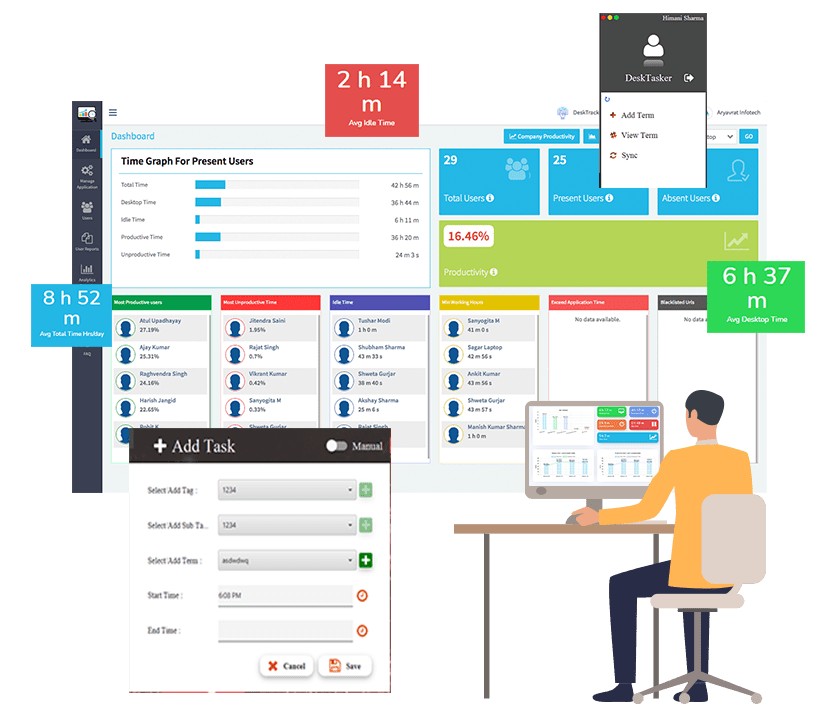A happy work environment that motivates and satisfies its employees is essential for a successful business. While many people confuse productivity and efficiency, they are not the same thing. It is important to note, however, that the two terms do not refer to the same thing. The distinction is one of quality versus quantity.
People who are productive, for example, get things done. However, a person may achieve short-term success if they do not develop a long-term strategy. As a result, efficiency and productivity are frequently at odds.
This blog post discusses the distinctions between efficiency and productivity, as well as their relationship and some tips for improving both.
What Exactly is Productivity?
A person’s productivity measures how much they accomplish in a given amount of time. Productivity is measured as output per hour. Focused employees produce more results in less time and assist businesses in increasing productivity.
The productivity of a business can also be expressed as its efficiency. Organizations must reduce the time spent on tasks of low value to their customers or organisations in order to increase productivity. Also organization should understand employees the importance of time management skills.
Productive workers are more likely to be motivated, creative, and innovative, and to produce better results than ineffective or very ineffective workers. Quantity (outputs) and quality (how well they achieve their intended goals) are taken into account when determining productivity.
What exactly is efficiency?
Efficiency is the result of reducing the time and effort required to achieve the desired results. Efficiency is defined as the ability to do things correctly, whereas productivity is defined as task completion.
For example, an efficient person would take the shortest route from point A to point B. You may be productive if you complete tasks quickly, but productivity does not guarantee quality.
Maintaining an efficient workplace can help you save time and money. Organization and knowledge of what needs to be done are required for efficiency. Divide activities into smaller components, set deadlines, and use checklists are all efficiency-boosting strategies.
The Relationship Between Productivity and Efficiency
Efficiency refers to doing the same amount of work in less time, whereas productivity refers to doing more work in the same amount of time. Even though productivity and efficiency are two distinct concepts, we must recognise their interdependence. If productivity represents quantity, efficiency will be the quality of output.
In other words, if resources are scarce, the work process will be less efficient, resulting in lower productivity. The efficiency with which a company uses its resources ultimately determines its productivity. To achieve true productivity, quality and efficiency must be added to output, and productivity must be added to efficiency.
How to Boost Work Productivity and Efficiency
Try incorporating the tips we’ve provided into your daily routine to increase your or your employees’ productivity and efficiency.
Concentrate on one task at a time.
You may be more productive if you concentrate on one project or task at a time rather than juggling several at once. When we focus on more than one activity at a time, we tend to spend more time transitioning between them. As a result, work may be incomplete or of lower quality than if each task was dedicated to itself.
As a multitasker, you may notice that you start more things than you can finish, so prioritise your projects in order of importance so that you can work on your most important assignments first and then move on to lighter, less time-consuming tasks later.
Prioritize your most important tasks first.
Working on your most important and time-consuming tasks first makes it easier to stay focused on other assignments. Plan your assignment list around these tasks, and devote your time to them when you are most alert and energized, such as when you first arrive at work in the morning.
Set small goals for yourself.
Consider scheduling small goals throughout the day rather than focusing on large goals that require multiple outlets and long periods of time to complete. During your eight hours of work, you can set and achieve daily goals such as filing paperwork for your project, responding to four client emails, or gathering all of the resources your team will need to complete it. These short objectives can be used as milestones to track your progress toward a larger goal.
Increase the effectiveness of meetings.
If you have meetings scheduled throughout the day, think about ways to improve your work progress. Stand-up meetings can be beneficial because you and your colleagues can see each other at the same time. It can assist you in remaining alert and focused when discussing critical topics during your meeting.
You can also use time tracking to determine how long it takes to attend and end a meeting. For example, allot a certain amount of time to each topic and make a list of the most important takeaways or themes that must be addressed. Then, work with your team to only discuss the topics on the topic list and to keep topic conversations within the timeframes specified.
Conclusion
Although walking the tightrope between efficiency and productivity is difficult, it is necessary for producing consistent results. By using productivity monitoring software we can measure employees productivity. whether you are an individual or a business. Remember that everyone faces difficulties from time to time. To overcome obstacles as effectively as possible, incorporate the advice we’ve provided into your daily routines.









































